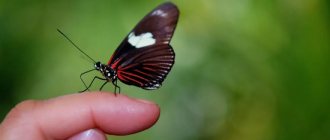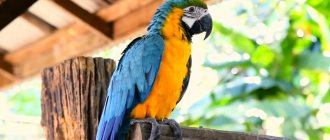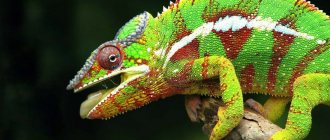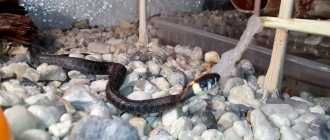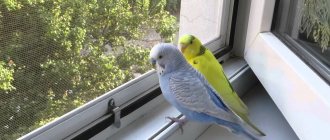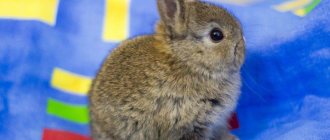Varieties
There are 45 recognized species in the iguana family, including several endangered species. These cold-blooded creatures come in different shapes and colors. Their size varies from 12.5 to 200 cm, more than half of which is on the tail. The body weight of adult individuals ranges from 30 grams to 14 kg. Moreover, males are usually larger and heavier than females.
Photo: VALERIE T.
The most famous species is the common or green iguana (Iguana iguana). It is found in the territory from the southern regions of Mexico to Brazil. She can often be seen basking in the sun on tree branches overhanging the water. The common iguana is green with dark stripes forming rings on its tail; females are grayish-green, weighing about half that of males.
- The longest iguana is the green iguana, which has a body length of 1.5 to 2 meters, including the tail.
- The smallest iguana is the spiny iguana, growing from 12.5 to 100 cm in length, including the tail.
- The heaviest iguana is the blue iguana, gaining weight up to 14 kg.
Maintenance equipment
- Iguanas, like any other reptile, cannot be kept without a terrarium. To keep an ordinary iguana you will need a vertical terrarium with well-closing doors. For a child and a teenager, a terrarium of 45*45*90 cm or larger is suitable; for adults, a terrarium three to four times larger will be required.
- The terrarium must be heated using heating lamps. A lamp with a lamp is installed on one side of the terrarium above the snag where the iguana will sit; the temperature in this warm point should be 35-38 ° C. In the coldest corner the temperature should not be lower than 24 °C. The lamp is installed so that, while warming itself, the animal cannot accidentally burn itself, so all lighting fixtures are installed outside the terrarium, on top of the ventilation mesh. The temperature must be monitored with a thermometer. At night, additional heating will not be required if the temperature in the terrarium does not drop below 18 degrees.
- A woody substrate is perfect as soil for a terrarium with an iguana; it holds moisture well and allows the animal to drip it.
- The free space is filled with wide and stable snags, vines, live or artificial plants, behind which the iguanas can hide.
- For lighting it is required to install full spectrum lamps: daylight, ultraviolet. Particular attention should be paid to ultraviolet lamps; without them, the animal will not produce vitamin D, thereby not absorbing calcium, which will lead to disease. All light lamps work for 12-14 hours during the day and turn off at night. It is advisable to install night lighting in the terrarium, for example a Full Moon lamp. This will reduce your pet's stress associated with abruptly turning off the lights and allow him to find a secluded place to sleep.
- The iguana loves to swim; a spacious drinking bowl is placed in the terrarium, into which it could fit entirely. The humidity in the terrarium should be high: from 70 to 90%. To maintain it, the terrarium is sprayed with a spray bottle several times a day (use distilled or osmotic water to avoid deposits on the walls). For convenience, you can install an automatic precipitation supply system. The soil should be moist, but water should not accumulate at the bottom. There should be no swamp in the terrarium. Use a hygrometer to monitor humidity.
- Since high humidity is maintained in the terrarium, in order to avoid various skin diseases, use the terrarium only with a proven ventilation system that promotes good air exchange and prevents glass from fogging.
Geographical distribution
Iguanas are a group of large lizards that live in the temperate climate zones of North, Central and South America, as well as Fiji, the Antilles and the Galapagos Islands.
Iguanas live mainly on land , among stones, in rock crevices and in trees. Most of them prefer to settle near large bodies of water. These are very good swimmers and divers. Adult male Galapagos marine iguanas can dive to depths of up to 30 meters .
Notably, many species are not native to the places where they currently live.
Habitat
The green iguana is one of the most widespread species of lizard, its original range spans the tropical regions of the Western Hemisphere from southern Mexico south to central Brazil, Paraguay and Bolivia, east to the Lesser Antilles. In the second half of the 20th century, lizards were introduced to Grand Cayman, Puerto Rico, the Virgin Islands, the mainland states of Florida and Texas, and Hawaii. The habitat of the green iguana is a variety of biotopes with dense woody vegetation: tropical rainforests and mangrove forests, as well as open areas of sea coasts. They spend most of their lives on trees, usually growing along the banks of slow-flowing rivers. Iguanas are active only during daylight hours. They spend cool nights on thick branches in the middle and lower tier of trees, but with sunrise they try to climb higher, where they bask for a long time - sunbathing raises body temperature, and ultraviolet radiation produces vitamin D, which promotes digestion. Green iguanas are excellent climbers, and they are also good swimmers, with their bodies kept completely submerged in the water and their paws extended along the body, and moved with the help of sinuous movements of the tail.
Character traits
Coloring
Iguanas come in a variety of colors—usually bright green, blue, black, brown, gray, and orange—and these different color morphs often depend on where they originate. Woody species come in different shades of green, blue and yellow to blend in with their treetop environment.
Photo: floridensis
Lizards may have dark transverse stripes on the body and tail, shaded by light veins. The stripes can be jagged and discontinuous, forming a kind of "carpet pattern" .
Appearance
Iguanas have a slender body, slightly compressed laterally, a large head and a long tail with a jagged ridge that runs from the head to the base of the spine. The limbs are muscular with long toes and sharp claws. They may also have grooves on their tail and body.
These lizards have a vestigial third eye on the top of their head, known as the "pineal gland." It is sensitive to changes in light levels and movement. Iguanas also have a flap of skin hanging from their chin called a dewlap. The movement of the dewlap is the way iguanas communicate.
Photo: katrinapeebles
Natural adaptations
Because these highly adaptive animals can be found in a wide variety of habitats, each species has its own unique adaptations.
Marine iguanas of the Galapagos Islands are skilled swimmers . They usually limit diving to just a few minutes, but can stay underwater for up to 30 minutes. Their black color helps them warm up after being in the chilly waters of the ocean.
The green iguana is at home high in the trees of the rainforest. Other species, on the other hand, have natural adaptations that allow them to successfully survive in hot deserts or rocky areas.
Photo: BioLib
With an emerald body coloration with blue/white stripes, more noticeable in males, Fiji iguanas inhabit a variety of habitats, from coastal wetlands and lowland woodlands to tropical forests on the volcanic slopes of the archipelago. They are characterized by long toes with pointed claws and elongated tails that help them maintain balance in the treetops. Rarely found on the ground, these striped iguanas climb from tree to tree using overlapping branches.
Eating habits
They are predominantly herbivores , eating a plant-based diet. These lizards have a well-developed digestive system, which contains bacteria that ferment plant material. Depending on their habitat, the diet of iguanas may consist of leaves, buds, flowers, fruits and fruits of fig trees.
Photo: pchoui
In addition to plants, rock iguanas eat insects, slugs, land crabs and carrion. Desert iguanas are leaf-living animals that prefer a diet of leaves; but they also eat flower buds and sometimes insects. Some species are sometimes not averse to eating a juicy worm.
Marine iguanas dive into the ocean to scrape algae and sea larvae from rocks.
And green iguanas, in order to speed up their growth, in their youth also add invertebrates, spiders, insects, small birds and mammals to their diet.
Basking in the sun is important for the digestion of members of the iguana family, and when ambient temperatures drop, the animals reduce their food intake.
In zoos and safari parks, iguanas are offered a fruit salad , which includes dark leafy greens and a variety of fruits. They additionally receive crickets, mealworms and waxworms. But because waxworms contain a lot of fat, they are considered a “dessert” part of the menu.
Social structure
Photo: shikhei goh
Iguanas are solitary animals. During the rainy season, males become territorial , and form pairs exclusively for mating. The hatchlings may remain together in kin groups for a short period of time after leaving the nest.
Male iguanas show aggression towards other males in order to attract the attention of females and bask in the sun. Physical combat is rare and usually occurs between opponents of comparable size. During fights, significant damage can be caused to both parties.
Iguana diseases
A newly purchased iguana should be shown to a veterinarian. In the future, such inspections should be carried out annually. If any symptoms occur, consult a doctor immediately.
Diseases of iguanas at home:
- rhinitis, pneumonia;
- mechanical damage to the skin;
- fractures;
- metabolic disease;
- diseases of the digestive system;
- disruption of the molting process;
- salmonellosis;
- fungal infection;
- mites;
- eye diseases.
Rhinitis
Mechanical damage to the skin
Fracture
Metabolic disease
Digestive diseases
Violation of the molting process
Salmonellosis
Fungal infection
Ticks
Eye diseases
For prevention, it is necessary to follow the pet’s diet, create the necessary climate in the terrarium, and maintain order in it.
Breeding season and young development
During the mating season, males establish a territory, which is usually in an area with dense branches and close to water, where they can meet more females. Males will fiercely defend their chosen territory from potential rivals.
Photo: ricardo_sanchez
Females migrate en masse to lay eggs at the end of the rainy season , in February or March. Females of most iguana species choose sunny places for nesting. Even arboreal species leave trees to lay eggs. The female lays her eggs inside a dug hole, covers them, and then leaves them alone.
From 20 to 70 eggs are buried to a depth of 30 cm in damp sand or soil. For development, future offspring need a stable temperature of 25 to 32 degrees Celsius, which is quite feasible at the beginning of the dry season.
Incubation lasts from 65 to 115 days. The hatchlings have a special tooth, called a "caruncle" , which is used to pierce the eggshell. The tooth falls off shortly after hatching. All the young in a burrow usually hatch at the same time, and the young are dug out of the burrow without parental assistance. After this, the cubs try to stay together. At this time, eggs and young animals are especially vulnerable to omnivores.
Photo: Living with Lizards
Several Caribbean species, collectively known as rock iguanas , are found on only one or two islands. Female rock iguanas lay 5 to 20 relatively large eggs annually; large eggs lead to large hatchlings, which evolved in response to the lack of local predators. Unlike their mainland counterparts such as green iguanas, island iguanas do not need to produce many offspring in response to their high vulnerability to predators.
- Age of sexual or reproductive maturity: 3 to 6 years
- Reproduction method: oviparous
- Incubation period: 2 to 4 months
- Number of eggs laid: several dozen, depending on the species
Nutrition
Unlike most other species of the family, green iguanas are exclusively herbivores, feeding on the leaves, shoots, flowers and fruits of about 100 species of tropical plants. Young lizards often eat the excrement of adult animals to meet their needs for the microflora necessary to digest low-calorie vegetarian food. Animals are not able to chew food; they only cut off fairly large pieces with their small teeth and immediately swallow them whole. Occasionally, iguanas drink water, plunging part of their head into the pond and swallowing it, or lick drops from greenery.
Lifespan
Depending on the species, iguanas can live from six to more than 60 years. The Cayman Islands rock iguana has the longest lifespan, ranging from 25 to 40 years in the wild and over 60 years in captivity. In the wild, green iguanas have a life expectancy of eight years, although in captivity they can live 20 years or more. In comparison, the marine iguana has a short lifespan of just over six years.
Photo: wildestanimal
Save Status
Iguana species vary greatly not only in color, size and behavioral traits, but also in their conservation status in the wild. Some, such as the common iguana, are widespread in their natural and introduced habitats; other species, on the other hand, are vulnerable or endangered.
Threats to iguana populations include:
- habitat loss and destruction due to land clearing for housing, agriculture and livestock;
- the appearance of exotic animals preying on iguanas and their young;
- capture for sale as pets;
- poaching.
The Galapagos pink iguana, which has an estimated population of 192 individuals and a range of about 25 square kilometers, is critically endangered. Much of the population loss is due to rats and feral cats living on the island.
Photo: BBC Earth
The Exuma Island rock iguana, which exists in the popular tourist area of the Bahamas, is in danger of extinction due to the negative impacts of additional visitors to the island, as well as changes to the flora and fauna of its natural habitat. Plantations, homes and resorts have destroyed the plants that the iguanas fed on, and traffic has become one of the biggest threats to the free-roaming animals.
Iguanas also have many different natural predators:
- hawks;
- owls;
- snakes.
In addition, adult iguanas have been consumed by humans for thousands of years. In rural areas they are the main source of protein. Young iguanas are especially vulnerable to attack by wild cats, and no individual is safe from a pack of dogs. The only way iguanas defend themselves is to strike with their tail with sharp “spikes”.
Some species that were once abundant are now beginning to disappear. There are several measures that can help iguanas survive, such as managed care breeding, restrictions on hunting and trapping, and educational programs for people living in or near iguana habitats.
A technique called "headstarting" : iguana eggs are incubated indoors and the hatchlings are kept in large pens until they are large enough to protect themselves from predators, giving them a head start in the wild. Some individuals are relocated to smaller, uninhabited and protected islands or reefs where they can thrive.
Did you know?
- In the animal kingdom, males are often the most vibrantly colored, but not among green iguanas; males are often bright orange, females are green, and juveniles are bright green.
- Some iguanas' stripes can change color from green to blue, gray or black, depending on mood, temperature and changes in environment.
- Striped and marine iguanas may secrete excess salt through their nostrils.
- Iguanas have atrophied venom glands that produce a weak, harmless poison.
- Green iguanas are agile climbers and can fall from heights of up to 18 meters without injury.
- The tail of these reptiles can break off and regenerate again, like those of chameleons.
- Males secrete a fluorescent substance from glands in their legs. It can be used to communicate with other individuals and mark personal territories.
Communication with an iguana
At home, the iguana behaves generally calmly and is quite unpretentious. But still, for safety reasons, a number of conditions must be observed. For example, to tame a young iguana, you need to communicate with it more often. You should hold the reptile in such a way that you press its front legs to the body with one hand, and the hind legs with the other hand:
- You can’t press the lizard too hard - you can damage its organs, and it can bite in pain.
- If you grab an iguana's tail, it may lose it. Without a tail, it is difficult for a reptile to maintain balance on branches. A new tail in young individuals will grow quickly, but in the older generation it may not grow at all.
The iguana must be removed from the branch very carefully so as not to damage its firmly grasped paws or claws.
To tame domestic iguanas, you need to handle them daily.

